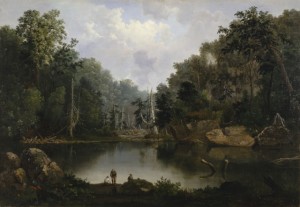- A Plan To Eliminate Wild Mute Swans Draws Vocal Opposition : NPR 031114
A plan in New York state to has drawn protests and petitions on all sides. While some see elegant white birds gliding across the water, others see a dangerous aggressor destroying the local ecosystem. | According to the state Department of Environmental Conservation, the swans — which don’t honk but make hoarse, frog-like grunts — are not native, and they destroy and attack native species. Amanda Rodewald, director of conservation science at Cornell University, says they’ve threatened loons and least terns. | "We are worried about them in New York because of the black tern population that we have," Rodewald says. Black terns there, she says, have only a few nesting colonies remaining. | The swans eat and pull out large amounts of submerged aquatic vegetation, destroying food sources for other birds. But what makes a nonnative species invasive? | Adam Welz, an ornithologist and filmmaker who lives in Brooklyn, says that when European songbirds were introduced in America, they failed to take. But in 1890, when a group of Shakespeare enthusiasts released 60 European starlings in Central Park, they multiplied into the millions.
- Home | Project SNOWstorm
Project SNOWstorm* is a collaborative research effort by Project Owlnet, the Ned Smith Center for Nature and Art and many independent researchers, agency and organizational partners. We are working together to learn more about the historic snowy owl irruption of 2013-14. [*SNOW is the four-letter code that bird banders and birders use for the Snowy Owl.]
- Trapping And Tracking The Mysterious Snowy Owl : NPR 031114
Snowy owls are among the largest birds in North America, but scientists know very little about their behavior. The owls spend most of their days far from humans, hunting rodents and birds in the flat expanses of the Arctic Circle. In the winter, the owls move south, but they don’t usually reach the United States. Most years, only a few are spotted in the northernmost states — a rare treat for birders. But this winter was different. | Owls started to appear all over the United States right around Thanksgiving — in Nebraska, in Kentucky — even as far south as Georgia. , a biologist with the Maryland Department of Natural Resources, was shocked when he saw not one but two snowy owls on a small stretch of Maryland beach. | Something huge is going on," Brinker told his colleagues. "We won’t see something like this for a long time — probably for the rest of our lifetimes." | This rapid population boom — called an "irruption" by ecologists — is the largest the East Coast has seen in 40 or 50 years.
About the Ghost Turtles
150 years after Robert Duncanson painted this luminist scene on the Little Miami River, I stood in the same spot and saw a soft-shelled turtle sunning on a snag. It slipped silently into the water when it heard me. That’s when I knew past is present and destiny, too. That’s when my vision of the Ghost Turtles began. Read more
Ecology of the Senses
 Returning to Lake Superior year after year like a migrating loon, I’ve learned the other side of a slow, uncertain process that could be called “going blind.” With the lake as my teacher, I know what lies on the other side. I call it letting go of sight. Read more.
Returning to Lake Superior year after year like a migrating loon, I’ve learned the other side of a slow, uncertain process that could be called “going blind.” With the lake as my teacher, I know what lies on the other side. I call it letting go of sight. Read more.Prayer at Big Creek
![Sandhill cranes land on Platte River sandbar roosts west of Rowe Sanctuary’s Iain Nicolson Audubon Center southwest of Gibbon, Nebraska. [Photo by Lori Porter| Kearney Hub]](https://www.ghostturtles.com/wp-content/uploads/2015/03/sandhill_cranes_kearneyhub_032015-300x225.jpg) At the threshold of consciousness, as I slipped back and forth between two worlds, I put my mind in the best place I could imagine, a marsh on Lake Erie called Big Creek. I knew I’d find cranes waiting for me. I cannot say whether I prayed for them, or to them, or with them. The cant of words doesn’t matter. I believe in the still, small voice. I believe what the poet Yehuda Amichai said. Gods come and go. Prayer is eternal. Read more
At the threshold of consciousness, as I slipped back and forth between two worlds, I put my mind in the best place I could imagine, a marsh on Lake Erie called Big Creek. I knew I’d find cranes waiting for me. I cannot say whether I prayed for them, or to them, or with them. The cant of words doesn’t matter. I believe in the still, small voice. I believe what the poet Yehuda Amichai said. Gods come and go. Prayer is eternal. Read moreFreedom to Read
![An endangered Whooping crane takes flight. Yhe large bird has a 7-foot wingspan. It is all white except for black wing tips and face markings. In this photo its long neck stretches forward; its wings sweep upward; and its black legs trail straight behind it. [Source: International Crane Foundation]](https://www.ghostturtles.com/wp-content/uploads/2023/03/Whooping-crane-eastern-ICF-080622-300x157.jpg) Whenever I hear sanctimonious pronouncements about woke, parental rights, and banning books, I think of Whooping cranes. In my family, the gawky, audacious, elusive and endangered birds are synonymous with our values about the First Amendment and the freedom to read. Read more.
Whenever I hear sanctimonious pronouncements about woke, parental rights, and banning books, I think of Whooping cranes. In my family, the gawky, audacious, elusive and endangered birds are synonymous with our values about the First Amendment and the freedom to read. Read more.Sister, Teacher, Pathfinder
 A guidance counselor in high school told my sister Diana, “With your eye problems you will never make it in college. Just forget about it. Get married. Raise a family.” That advice only deepened her determination. She did it all in due time, in her own way –college, marriage, family. She became a guidance counselor herself. She certainly was the most important guide and pathfinder in my life. Read more.
A guidance counselor in high school told my sister Diana, “With your eye problems you will never make it in college. Just forget about it. Get married. Raise a family.” That advice only deepened her determination. She did it all in due time, in her own way –college, marriage, family. She became a guidance counselor herself. She certainly was the most important guide and pathfinder in my life. Read more.Flaneur & Bouquiniste
![Mark Willis peruses a 1745 volume by Voltaire at a bouquiniste book stall on the banks of the Seine in Paris. He wears a brown leather jacket and checkered flat cap. He holds the open book in his hands. Rows of old books are seen on shelves behind him. [2005 photo by Ms. Modigliani]](https://www.ghostturtles.com/wp-content/uploads/2023/03/mw_bouquiniste_05-300x225.jpg) I remember the book I held in my hands that day. I remember the feel of its time-warped, water-stained pages. I remember its murky, moldy river smell, call it the book’s bouquet, suggesting years of storage on the banks of the Seine. Had I bought it then, I could feel and smell it now and know it from a hundred other books in my library. Read more.
I remember the book I held in my hands that day. I remember the feel of its time-warped, water-stained pages. I remember its murky, moldy river smell, call it the book’s bouquet, suggesting years of storage on the banks of the Seine. Had I bought it then, I could feel and smell it now and know it from a hundred other books in my library. Read more.R & K: A Rant
 Marjorie Taylor Green auditioned for R&K’s Authoritarian It Girl at the 2023 State of the Union address. She and her Republican colleagues yelled like Tarzan swinging through the trees as they jeered and booed the President’s speech. Read Rants & Kisses.
Marjorie Taylor Green auditioned for R&K’s Authoritarian It Girl at the 2023 State of the Union address. She and her Republican colleagues yelled like Tarzan swinging through the trees as they jeered and booed the President’s speech. Read Rants & Kisses.R & K: A Kiss
 Songs by Burt Bacharach and Hal David. Singers like Dione Warwick and Dusty Springfield. What Do You Get When You Fall in Love? The Look of Love. I Say a Little Prayer. I sit in the car’s back seat and listen. I’m glad it’s dark. I’d be embarrassed if anyone could see the dreamy look on my face. Read Rants & Kisses.
Songs by Burt Bacharach and Hal David. Singers like Dione Warwick and Dusty Springfield. What Do You Get When You Fall in Love? The Look of Love. I Say a Little Prayer. I sit in the car’s back seat and listen. I’m glad it’s dark. I’d be embarrassed if anyone could see the dreamy look on my face. Read Rants & Kisses.


I am a swan fan. I am a hunter also. But to destroy the swan population is unthinkable. All along the eastern seaboard there are egg shaking programs to shake swan eggs and I understand about keeping different species under control to preserve wetlands and control disease among the animals, etc. According to the newspaper article I read this morning in The Buffalo News there are 5000 Mute Swans living in NYS but mostly along Long Island and the NYC area. If it hasn’t been done, egg shaking would be a good deterrence to the increasing population or capture and relocate. I think the DEC would be better off bringing Moose, bears, and other animals that used to be native back to NYS, put more effort into poaching, anything but killing the beautiful majestic birds.